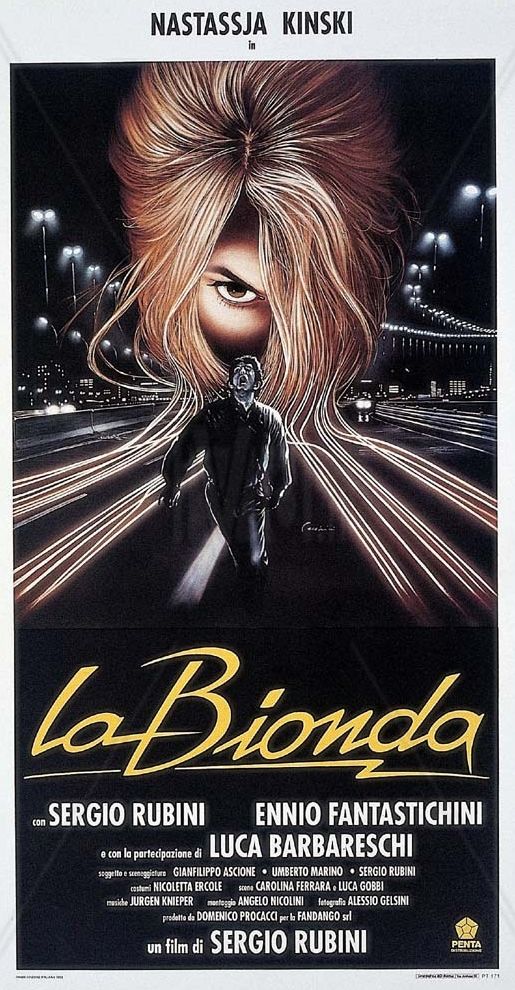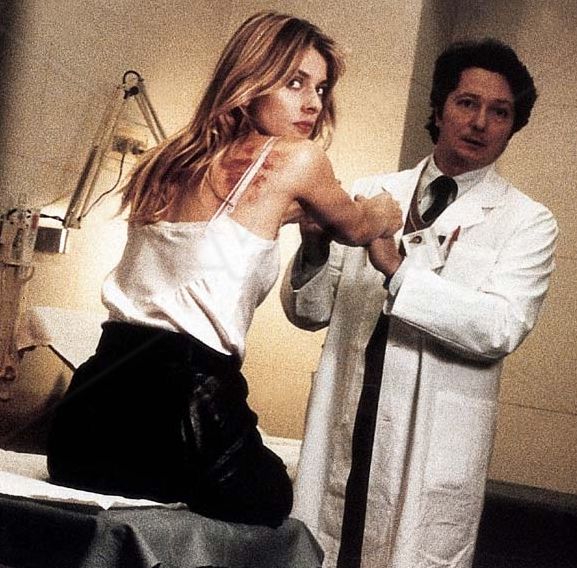Dir: Sergio Rubini
Star: Sergio Rubini, Nastassja Kinski, Ennio Fantastichini, Veronica Lazar
a.k.a. The Blonde
 This occupies a position somewhere between drama and thriller, and isn’t entirely satisfactory as either. The hero is Tommaso (Rubini), a young man studying watchmaking into Milan, who runs into a young woman named Christine (Kinski). Literally runs into her, when he’s pulling away from a set of traffic lights. She’s not badly hurt, but the incident appears to cause a bout of amnesia, and after being released from hospital, she turns up on his door-step, desperately seeking his help. What would you do if Nastassja rang your doorbell, saying she couldn’t remember anything? Exactly. Except, a few days later, she vanishes – either cured of her amnesia, or abandoning the pretense, the film largely avoids answering that question.
This occupies a position somewhere between drama and thriller, and isn’t entirely satisfactory as either. The hero is Tommaso (Rubini), a young man studying watchmaking into Milan, who runs into a young woman named Christine (Kinski). Literally runs into her, when he’s pulling away from a set of traffic lights. She’s not badly hurt, but the incident appears to cause a bout of amnesia, and after being released from hospital, she turns up on his door-step, desperately seeking his help. What would you do if Nastassja rang your doorbell, saying she couldn’t remember anything? Exactly. Except, a few days later, she vanishes – either cured of her amnesia, or abandoning the pretense, the film largely avoids answering that question.
We then find out exactly what she was running from, and why the amnesia might have been faked. She’s hanging out with a highly-dubious character (Fantastichini) who is currently working with a bent cop, on a massive deal involving drugs stolen from police custody. He uses Christine as his go-between, while simultaneously denying her existence to all and sundry. But Christine is increasingly disenchanted with her position as a gangster’s moll, and has dreams of heading off to South America, to resume her career as a singer. Tommaso tracks down his temporary guest, but she initially spurns him. He won’t take no for an answer, and it this persistence that leads to the dramatic conclusion. For, while supposedly dropping off payment for the drugs in a locker, Christine is actually on her way to catch a flight abroad. An unfortunate phone-call from Tommaso blows the gaff on her scheme, alerting her “employer”, and all three sides of the love triangle head to the airport for a final confrontation on a lonely highway.
Rubini appears to be going for an Italo-noir feel to things here. But unlike, say, the spaghetti Westerns, which developed a distinctive look and became their own animal, this seems more concerned with aping the tropes and style of the genre. Particularly early on, it’s too self-absorbed for its own good. For example, there’s a scene on a subway, where Tommaso is with Christine, and is embarrassed when a disabled passenger urges him to occupy one of “their” seats. Which came as a surprise to me, because I hadn’t realized to that point Tommaso is actually disabled himself, it only becoming clear later that he walks with a pronounced limp. Was this me, not paying sufficient attention? [Let’s face it, whiny male leads in Kinski films probably aren’t getting much of my focus] Or the film being too understated for its own good? You’re also spending a lot of time watching people who are inherently unhappy, not do much to change their situations, which I tend to find irritating. Yeah, your life sucks: deal with it.
 Things perk up a bit for the finale, though you do have to suspend your disbelief significantly. Milan is not exactly a small city, and one can presume its airport is similarly-sized. But the three protagonists here miraculously arrive at the same place at the same time, as if this was a one-gate facility in rural Montana. They then whizz off down a highway which is also so completely deserted, you wonder if the rapture had occurred. There’s not even anyone to be seen, driving past on a moped going “Ciao!” [Bonus point to you if you get that reference] Well, right up until the end, when the 16-wheeler necessary to the plot suddenly appears, like a diesel-powered deus ex machina, to tidy up the loose ends, and do what Tommaso apparently is unable to. As an aside, should mention on the copy I was watching, the audio was significantly out of sync with the video. For most of the film, that didn’t matter, because it was subtitled anyway, so that was in sync. But during the action finale, you’d have Nastassja apparently screaming her lungs out, with nothing to be heard, save the roar of the engines. It actually added a kinda surreal beauty to proceedings, like a waking nightmare.
Things perk up a bit for the finale, though you do have to suspend your disbelief significantly. Milan is not exactly a small city, and one can presume its airport is similarly-sized. But the three protagonists here miraculously arrive at the same place at the same time, as if this was a one-gate facility in rural Montana. They then whizz off down a highway which is also so completely deserted, you wonder if the rapture had occurred. There’s not even anyone to be seen, driving past on a moped going “Ciao!” [Bonus point to you if you get that reference] Well, right up until the end, when the 16-wheeler necessary to the plot suddenly appears, like a diesel-powered deus ex machina, to tidy up the loose ends, and do what Tommaso apparently is unable to. As an aside, should mention on the copy I was watching, the audio was significantly out of sync with the video. For most of the film, that didn’t matter, because it was subtitled anyway, so that was in sync. But during the action finale, you’d have Nastassja apparently screaming her lungs out, with nothing to be heard, save the roar of the engines. It actually added a kinda surreal beauty to proceedings, like a waking nightmare.
I do have to say, the cinematography was undeniably impressive, with Alessio Gelsini Torres doing a sumptuous job of capturing all sides of Milan, to the extent that it becomes another character in the film, and also making Kinski almost luminous in some scenes. Perhaps the most memorable scene is just after she has abandoned Tommaso, during an apparently happy shopping trip through town: his increasing concern, as he realizes she has indeed gone, is captured very nicely. However, moments like that are the exception rather than the rule, and I found all the characters here too self-absorbed to capture my interest or attention.